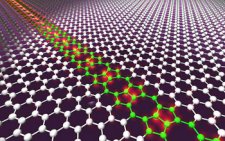
Posted on Monday, April 05 2010 @ 4:41 CEST by Thomas De Maesschalck
Researchers at the University of South Florida (USF) have created a new method for adding an extended defect to graphene, which effectively creates a metal wire in the sheet. The discovery may lead to smaller yet faster computers in the future. More info
at PhysOrg.
The team lead by USF Professors Matthias Batzill and Ivan Oleynik, whose discovery was published yesterday in the journal Nature Nanotechnology, have developed a new method for adding an extended defect to graphene, a one-atom-thick planar sheet of carbon atoms that many believe could replace silicon as the material for building virtually all electronics.
It is not simple to work with graphene, however. To be useful in electronic applications like integrated circuits, small defects must be introduced to the material. Previous attempts at making the necessary defects have either proved inconsistent or produced samples in which only the edges of thin strips of graphene or graphene nanoribbons possessed a useful defect structure. However, atomically-sharp edges are difficult to create due to natural roughness and the uncontrolled chemistry of dangling bonds at the edge of the samples.
